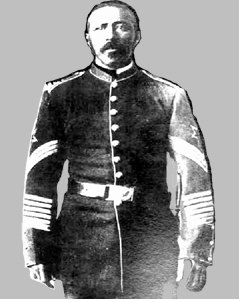
Sergeant
Moses Williams
Medal of Honor Recipient
 Moses Williams, born on October
10, 1845, in Carrollton, Louisiana, was probably the son of slaves. In 1866, he enlisted in the 9th Cavalry, one
of two newly authorized African-American cavalry regiments. These regiments gained fame as the "Buffalo Soldiers"
while serving on the Western frontier. Williams, illiterate like so many freedmen, signed his enlistment papers
with an "X," but his signature proudly appears on his first reenlistment papers in 1871. While serving as a
Buffalo Soldier, despite the arduous duties and long days in the field, Williams learned the reading, writing, and
mathematics skills needed to later become an Ordnance Sergeant.
Moses Williams, born on October
10, 1845, in Carrollton, Louisiana, was probably the son of slaves. In 1866, he enlisted in the 9th Cavalry, one
of two newly authorized African-American cavalry regiments. These regiments gained fame as the "Buffalo Soldiers"
while serving on the Western frontier. Williams, illiterate like so many freedmen, signed his enlistment papers
with an "X," but his signature proudly appears on his first reenlistment papers in 1871. While serving as a
Buffalo Soldier, despite the arduous duties and long days in the field, Williams learned the reading, writing, and
mathematics skills needed to later become an Ordnance Sergeant.
The 9th Cavalry was raised in Louisiana and sent to west Texas in the summer of 1867. Sergeants were appointed from the ranks. Within a year, Williams was promoted to First Sergeant of Company F. In 1871, following his first reenlistment, he was transferred to Company K to serve as First Sergeant. The 9th Cavalry served in west Texas until 1875, scattered out in a string of small posts protecting the mail and stage route between San Antonio and El Paso, Texas. In 1875, the 9th Cavalry transferred to New Mexico, where Williams reenlisted again in 1876 and was reassigned as First Sergeant of Company I.
While in New Mexico, the 9th Cavalry was embroiled in the Victorio War of 1879-1880 and a sequel known as Nana's Raid in 1881. Chief Victorio and his Warm Springs Apaches took to the hills, raiding farms and ranches rather than submitting to life on the reservation. It took a year to run Victorio to ground, but even after his death and the capture of most of his band, an old warrior named Nana escaped and, with about 40 others, continued raiding. A detachment of 22 troopers, including Williams, caught up with Nana on August 16, 1881. A running battle ensued, ending with a determined stand by the Apaches. During the fight, Williams repeatedly led flanking attacks. At one point, he personally rallied the detachment and brought it back into the fight. When the outnumbered cavalry was forced to withdraw, Williams and his lieutenant stood up to draw the enemy's fire enabling the unit to rescue three cut-off troopers. In 1896, he was awarded a Medal of Honor for his conspicuous gallantry that day.
Williams continued to serve in the 9th Cavalry until 1886, when his application for Ordnance Sergeant was approved. Ordnance Sergeants had to have at least eight years of service and a minimum of four years as a noncommissioned officer; they were also required to pass a physical examination as well as an examination by a board of officers. Williams was probably the first African-American Ordnance Sergeant. Williams reported to Fort Buford, North Dakota, where he served as Ordnance Sergeant until the post closed in 1895. When Fort Buford closed, he reported for duty to Fort Stevens, Oregon, at the mouth of the Columbia River. Fort Stevens was ungarrisoned at the time. During this period, the Corps of Engineers was in the process of building the West Battery to mount four of the latest ten-inch seacoast defense guns. As the Fort's caretaker, Williams was responsible for 22 large cannon, a magazine with 1,200 shots and shells, and the new guns, themselves.
Ordnance Sergeant Williams retired in 1898 after 32 years of service. Possibly retiring because of ill health, he died on August 23, 1899, at age 52 and was buried in the Vancouver Barracks Cemetery. The old Buffalo Soldier and Ordnance Sergeant serves as a shining example of service to country, bravery, endurance, self-improvement, and leadership.